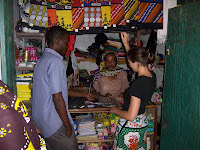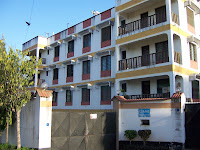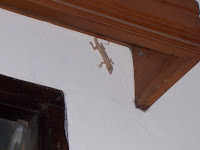Friday, April 18, 2008
Home is where the heart is...
Although our time in Kenya is over we still have several things to share with all of you so keep an eye out for new posts. We will continue to share experiences and pictures after we get back home.
Village Life
The original Yehu office and our home in Mwambalazi.
So we survived the village! I won't lie, it was rough. The people who live like that are tough people - we are less tough! The hardest part was not sleeping. It was so hot with no fans and we were both in a bed just barely bigger than a twin with a mosquito net that didn't really fit over it, so it was pretty miserable. We walked about 15k (we think that's about 10 miles) and with no sleep it was brutal. Other accomodations included solar electricity which gave us a little light at night and no running water. We had to take what we wanted to drink with us. The bathroom was like and outhouse, but no toilet, just a hole in the ground! That was a challenge for some of us. :)A Centre Meeting
It was hard to belive that people live like that, and that is actually how about 95% of Kenyans live. At the office where we stayed we kept seeing people walk by with water jugs and then coming back with it full on their heads, so we asked one of the employees in the office to take us to see the well. It was just a hole that had been dug at the bottom of the hill to catch the rain water. The people use that water for drinking, cooking, and bathing. It was amazing.
For me one of the neatest things was how bright it was at night time. A few hours after sundown we would walk about a half mile to eat dinner at a little restaurant (a very small mud hut with some small hand made bench seats and tables). We did not need flashlights for the walk. We could see the road, and everything around us with ease. I couldn't believe how bright it was. The sky and stars were very clear and beautiful.
Tuesday, April 15, 2008
Saturdays at the Beach
We learned the hard way that staying on hotel property is the best way to enjoy the beach. They are very welcoming and accommodating especially if you spend some money there. We love to do laundry in the morning and then reward ourselves with lunch at the hotel, poolside, overlooking the blue water. Our first week at the beach we were so excited to feel the sand in our toes we headed straight there and little did we know that as soon as we hit the sand we were the prime target for the beach boys. Unfortunately these beach boys won’t sing us a good song, just the “welcome my friends, come see what I can sell you” song that we’ve heard so many times. We walked about 20 yards and were not left alone and could see several more headed our way so, disappointed, we headed back to the hotel. We have since learned to enjoy the beach from our favorite hotel, Mombasa Beach Hotel. We have made some friends with the staff and learned that if we leave our things at the hotel and look like we have nothing with us we are mostly left alone as we enjoy our long walks on the beach. It is so nice to be able to relax and finally have a good reason to feel hot and sticky!
I'm SO excited to be at the beach!
One of our first weeks, still a little pale!
Last week we gave into the tourists in us and rode a camel! We have seen them every week and it was something I couldn’t go home without experiencing. I thought it might be romantic, like riding horses along the beach, but it was way cooler than that! They are such huge animals! Our camel’s name was Bob Marley and he likes mangos and bananas. He got down on his knees so we could climb on and then when he got up with his back legs I was looking at the ground. Then he got up with his front legs and it felt like we were 10 feet in the air. It was a very cool experience.
We have only suffered the occasional minor sunburn and have thankfully not noticed any side effects from our anti-malaria medicine that can cause sensitivity to the sun! The beautiful Kenyan coast is something we have enjoyed getting used to and will miss a lot.
Friday, April 11, 2008
Nakumatt
A place where we feel a little more at home is the Nyali Nakumatt. This is where we do our grocery shopping and it is very much like a small version of Wal-Mart. (Even grocery stores in Kenya are amazing places, Dad!)
They have everything from bread to entertainment systems, hardware to yoghurt. We can find things like Kellogg’s cereals (which we don’t buy because they are about $15 a box), whole milk in a bag, Heinz ketchup (again super expensive), maize flour, Twix (that melts as soon as you step outside), laundry soap, insect killer, packaged meat (not the animal still to be cleaned), pasta and Prego, etc, etc. When we first arrived it was suggested that we shop at the Nakumatt because the markets were not safe. While we still stay out of the markets, we’ve found several fruit and vegetable stands on our way home where we like to by those things fresh. We’ve learned that Nakumatt usually gets their produce from the markets. That little tip has saved us from stock-piling too many fruits and veggies that go bad WAY faster in this hot and humid climate than at home. Unfortunately we still tend to get the mzungu price so it doesn’t really save us money! We usually shop about once a week and round trip takes us about 3 hours. I will not miss that when I can load my groceries into the trunk and be done for 2 weeks in about 30 minutes!
Tuesday, April 8, 2008
The Amazing Matatu
Matatus are the main form of public transportation. They are similar in shape and size to a Volkswagen van but they appear to be made by Nissan. They have five compact rows with three small seats in each row. Each matatu has a driver (who doesn’t count as a passenger) and a conductor (who does). The conductor takes your money and alerts the driver when passengers want to exit, or alight, as they say here. You can let the conductor know you want to get off by tapping on the metal sides of the van.
It takes skills to get in and out!
The matatus have a wide variety of horns and sounds which they use to get your attention so you will board their bus. The conductors will often try to talk you into going wherever their route will take you to get you in the van. If there are several matatus going to the same place the conductors will try to convince you that their van is better than the others and herd you in that direction, although the price is never dropped.Matatus don’t seem to follow any rules of driving. They are constantly cutting others off, stopping at any time to pick up a passenger and speeding as much as they can. Time is money after all. Although it is illegal they try to pack as many passengers into the van as possible if they think there are no cops ahead. As I mentioned the most Emily and I have been on with is 22 passengers.
This was a kid from church - don't worry I hardly ever do this to strangers.
We take matatus wherever we go each day. We know the prices for most of the routes we use by now but the conductors often try to over charge us. Our co-workers tell us that it’s because of the color of our skin and everyone assumes that white people, or colored people, as they say, have lots of money. This has been true with pretty much everything we have tried to buy for the first time. For example, the first time we took a bicycle ride (another form of public transport for short distances called a boda boda) the riders tried to charge us 200 Ksh each. I think we ended up paying 40 Ksh each and we later found out that the going rate is 20 Ksh. We have come to love price tags and despise bartering since we don’t know what a fair price is for most things.
Well we got a little off subject with this one but we feel that the tangent was apt.
What time is it? It’s laundry day!
I may have embellished a little bit. We actually haul our laundry up to the roof of our building where we have a large sink all of our own. We wash and rinse our clothes by hand and then we hang them on the line to dry. Neither of us is very experienced at doing laundry by hand, in fact we had never done it before coming to Kenya. We have, however, developed a pretty good system and it goes pretty fast. (About an hour to wash and hang one load. Then we wait several hours for the clothes to dry before we can put them away.) We always worry that we’re not getting them quite clean enough or that we’re not getting all of the soap out but we’re sure we use WAY more water for our laundry than our neighbors.
We always have to wash the sink before we can wash our clothes.
The dry cycle takes 3 hours for button-up shirts, 5 hours for t-shirts, 8 hours for pants!
After washing our clothes by hand for five weeks we have determined this. Now we have actually DONE laundry. All you washing machine people have never actually DONE laundry. You have loaded a machine that does it for you, but this is the real deal. (Any readers who have done laundry by hand may now pat themselves on the back) Don’t misunderstand; we don’t have anything against washing machines. In fact, we’re very much looking forward to enjoying that luxury upon our return home. We just think it’s a funny phrase we use when we don’t, in a way, actually DO the laundry.Thursday, April 3, 2008
Mmm…mmm…good!
Their other staple that every Kenyan woman must know how to make is ugali. If a woman gets married and cannot make ugali she is sent back to her family until she learns how. Ugali is simply maize (corn) flour added to boiling water and stirred to make a kind of dough (think grainy playdough). You eat ugali with your hands and it goes with a variety of different things including kachumbari (sliced tomatoes, onions and peppers drowned in the juice of a lime), skuma (boiled and seasoned kale – like spinach), cabbage, and some kind of meat – we’ve had fish.
The best meal according to a Kenyan is nyama choma – translated literally it’s grilled animal, but it just means any kind of meat. They are not picky about their meat and it often includes or mostly consists of bone and fat.
Another great Kenyan dish is pilau. It is rice with certain spices that give it an orange color and nyama choma. We’ve been told that it is common to slice a banana in with it and when we tried it we were very surprised that it was very good.
They eat everything with chapati. Chapati is like a thick tortilla, but more flavorful. They like to tear it into bite-size pieces and cover it with beans – either pinto beans or a kind of bean soup that tastes like lentils. The chapati soaks up the juices and it’s really good.
They love to drink hot things (tea, coffee, cocoa). There is a saying in Swahili, “When it’s hot, take it hot. When it’s cold, take it cold.” Well, it’s never cold, so we’ve been hard pressed to find anything cold! We haven’t tried anything we really didn’t like which has been a pleasant surprise! The abundant and very sweet bananas and other fruits have been a highlight, and good for us too.
Tuesday, April 1, 2008
Flat Sweet Flat
Our apartment is extremely nice by Kenyan standards. We have two bathrooms, three bedrooms, a kitchen, and a sitting room. We have running water but not heated water and a sink and line up on the roof for laundry. We have two gas burners which use a propane tank. We can’t drink the water from the tap but we buy big containers of water and we have a dispenser in the kitchen. You will know how nice our apartment is comparatively by remembering or re-reading the post from the 17th of March where we talked about visiting our friends at their home in Likoni. The overwhelming majority of Kenyans live like our friends in Likoni and very many live much worse.
Things we don’t have that we are all used to: a garbage disposal, laundry machines, air conditioning, an oven (not that we could use it in the heat) a normal sized refrigerator, hot water, TV, internet, and carpet.
Things that we do have that we’re not used to: a sink for laundry, mosquito nets to sleep in, four fans (two blowing directly on each of us) to keep us cool enough to sleep at night, common power failure, lots of bugs eating our food, and the occasional lizard.
Despite these differences we are getting along just fine and we’re gaining a greater appreciation for all that we have.
Monday, March 31, 2008
Meet the Staff
Bernice Githinji is the first person we met when we arrived in Mombasa. She gave up a Saturday to pick us up from the airport and take us to the store for food. She has a good sense of humor and is strong in her opinions. She often speaks to us in Swahili because she thinks we should know the language already. She is the Assistant to the CEO and we’re not sure what she does everyday! :)
Phoebe Mwanjala has a great laugh. She is always welcoming and willing to help us learn whatever she is working on. (Note: We have found when a word ends in an “I” or “Y” the sound will often be left off. Example: One of the branches of the bank is in Mwambalazi, but people usually say Mwambalaz) One of our favorite things about Phoebe is that she says almost every day that she “is feeling dizz” when she gets tired or hungry. It makes us smile! Phoebe has a husband and a little boy that she misses at home.
Friday, March 28, 2008
T-Shirts Anyone?
Yehu Microfinance Trust
Wednesday, March 26, 2008
Mzuri Safari
They may not be able to read, but they know numbers...even backwards. Our salesman was writing on the dirty window!

The view from our room in Tsavo East - Voi Safari Lodge at sunrise.

Reticulated giraffe (red), kongoni (hartebeest – a deer like animal), red elephant, Somali ostrich, lion, warthog, African wood owl, white bellied buzzard, corrie buzzard, hippo, common zebra, African buffalo, secretary bird, great spotted eagle, long crested eagle, lilac breasted roller bird, difesa (water buck), cheetah, dikdik (a tiny little deer – like as big as a house cat), mongoose, baboons, silver backed jackal, spotted hyena, crowned plover (bird), guinea fowl, wildebeest, vervet mokey, gazelle, impala, Egyptian geese, superb starling bird, Malibu stork, maasai giraffe (black), eurasain roller bird, yellow neck spar fowl, blacksmith plover (bird), crocodile, and some fish.
Our safari was four days and three nights. On the fourth day we made our journey home and it was good to be back in a familiar place. Of course you know already know about my getting sick and our visit to the hospital and all that. Here I am still sick and Emily is making me write all kinds of blogs before I can go to bed!! She’s harsh, but fair.









.jpg)

.jpg)


















.jpg)














.jpg)



.jpg)









